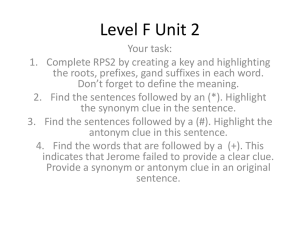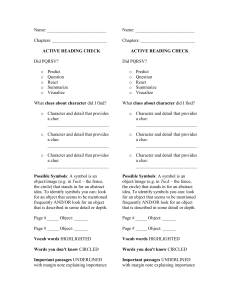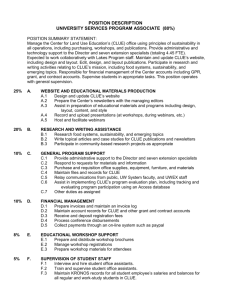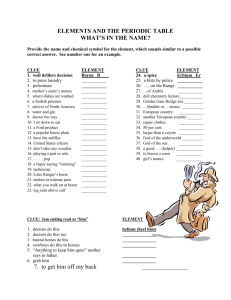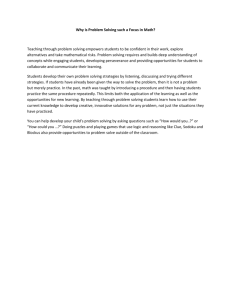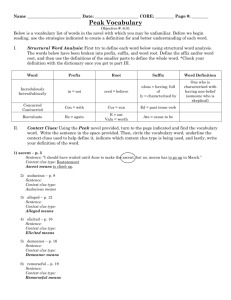The change in the seasons and cooling weather causes changes in
advertisement
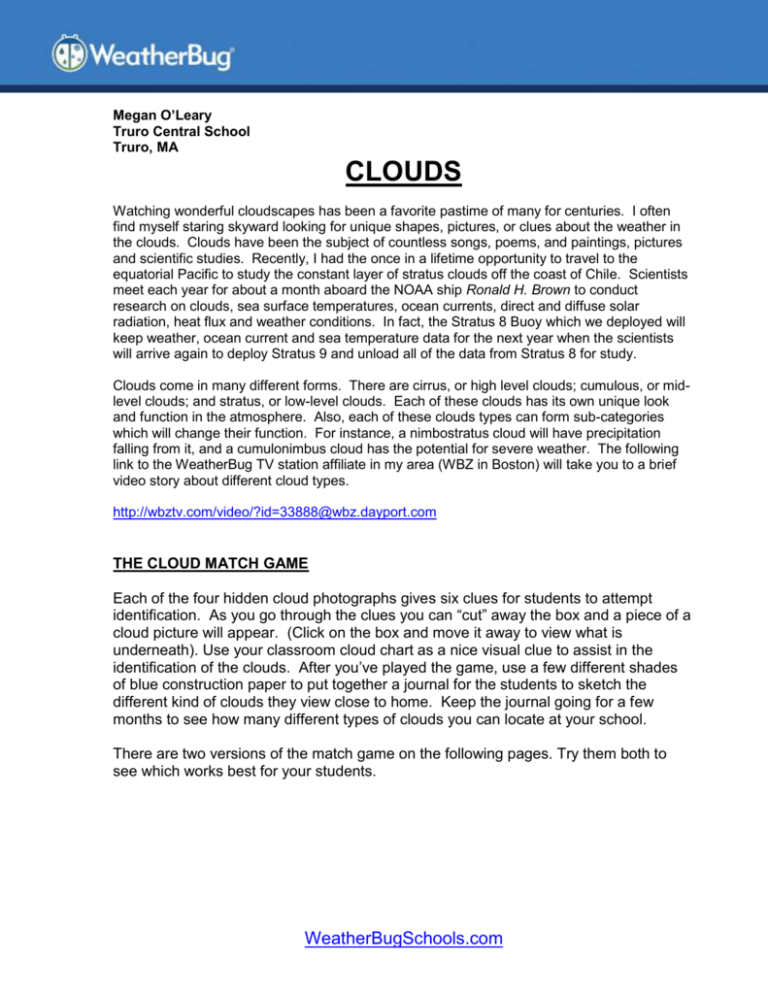
Megan O’Leary Truro Central School Truro, MA CLOUDS Watching wonderful cloudscapes has been a favorite pastime of many for centuries. I often find myself staring skyward looking for unique shapes, pictures, or clues about the weather in the clouds. Clouds have been the subject of countless songs, poems, and paintings, pictures and scientific studies. Recently, I had the once in a lifetime opportunity to travel to the equatorial Pacific to study the constant layer of stratus clouds off the coast of Chile. Scientists meet each year for about a month aboard the NOAA ship Ronald H. Brown to conduct research on clouds, sea surface temperatures, ocean currents, direct and diffuse solar radiation, heat flux and weather conditions. In fact, the Stratus 8 Buoy which we deployed will keep weather, ocean current and sea temperature data for the next year when the scientists will arrive again to deploy Stratus 9 and unload all of the data from Stratus 8 for study. Clouds come in many different forms. There are cirrus, or high level clouds; cumulous, or midlevel clouds; and stratus, or low-level clouds. Each of these clouds has its own unique look and function in the atmosphere. Also, each of these clouds types can form sub-categories which will change their function. For instance, a nimbostratus cloud will have precipitation falling from it, and a cumulonimbus cloud has the potential for severe weather. The following link to the WeatherBug TV station affiliate in my area (WBZ in Boston) will take you to a brief video story about different cloud types. http://wbztv.com/video/?id=33888@wbz.dayport.com THE CLOUD MATCH GAME Each of the four hidden cloud photographs gives six clues for students to attempt identification. As you go through the clues you can “cut” away the box and a piece of a cloud picture will appear. (Click on the box and move it away to view what is underneath). Use your classroom cloud chart as a nice visual clue to assist in the identification of the clouds. After you’ve played the game, use a few different shades of blue construction paper to put together a journal for the students to sketch the different kind of clouds they view close to home. Keep the journal going for a few months to see how many different types of clouds you can locate at your school. There are two versions of the match game on the following pages. Try them both to see which works best for your students. WeatherBugSchools.com Version 1 CLOUD #1 To begin: Cut out the image and each clue and cover the image as shown at the right. Remove clues one at a time to see part of the picture. Cumulus Cumulus Clue 1 Clue 2 Clue 3 I am a puffy cloud that contrasts the blue sky. I can be a fair weather cloud. If I grow tall, I can become a thunderstorm… Clue 4 Clue 5 Clue 6 I sometimes look like huge puffs of cotton. Sometimes I get dark and gray and rain and hail will fall from me. My name means heap, and I am classified as a mid-level cloud. WeatherBugSchools.com Clue 1 Clue 2 Clue 3 IClue am a4 puffy cloud I that someti contras mes ts the look blue like sky. huge IClue can 5 be a fair Someti weathe mes I rget cloud. dark If I 6 Clue grow tall, My I can name becom means eheap, a thunde and I rstorm am … classifi puffs of cotton. and gray and rain and hail will fall from me. ed as a midlevel cloud. CLOUD #2 To begin: Cut out the image and each clue and cover the image as shown at the right. Remove clues one at a time to see part of the picture. Cumulonimbus Cumulonimbus Clue 1 Clue 1 Clue 2 Clue 3 Sometimes I get dark and gray and rain falls from me. I can tower all alone or I can be part of a squall line. I have been known to reach more than 10 miles into the atmosphere. Clue 4 Clue 5 Clue 6 While my lower levels contain water droplets, my higher levels have been known to contain ice particles. Under favorable conditions, I can become a super cell thunderstorm that might even drop a tornado. I cannot be classified as a low, mid, or high level cloud. WeatherBugSchools.com Someti mes I Clue get 4 dark While and my gray lower and levels rain contai falls nfrom water me. droplet s, my higher levels have been known to contai n ice particl es. Clue 2 Clue 3 I can Clue tower 5 all alone Under or I favora can be ble part condit of a ions, squallI can line. beco me a super cell thund erstor m that might even drop a tornad o. I Clue have 6been know Cum In to ulon canno reach imb tmore be us classi than fied 10 as a miles low, into mid, the or atmos high phere level . cloud . CLOUD #3 Cut out each clue and cover the image as shown on the right. Remove the clue as to see part of the picture. Stratus Clue 1 These clouds bring gray days. Clue 4 I have been known to hide tall skyscrapers, and make it difficult for planes to land. Clue 2 Clue 3 I sometimes sit near the ground. Sometimes I am fog. Clue 5 Clue 6 My name means stretched or layers which is why I take up most of the sky. I am classified as a low level cloud. WeatherBugSchools.com Clue 1 Clue 2 These Clue clouds4 bring Igray have been days. known to hide tall skyscr apers, and make it difficu lt for planes to land. I Clue someti 5 mes sit near My the name ground mean . s stretc hed or layers which is why I take up most of the sky. Clue 3 Clue Some 6times I am St Ifog. am ra classi tu fied s as a low level cloud. CLOUD #4 Cut out each clue and cover the image as shown on the right. Remove the clue as to see part of the picture. Cirrus Clue 1 Clue 2 Clue 3 I am primarily composed of ice crystals. I am typically thin, wispy, white and feathery in appearance. I bring a magnificent array of colors to the sky when the sun is low on the horizon. Clue 4 Clue 5 Clue 6 I am common throughout North America at almost any time of the year. My name can be translated to mean curls of hair. I am classified as a high level cloud. WeatherBugSchools.com Clue 1 Clue 2 Clue 3 I am primari ly Clue 4 compos ed of I am ice commo crystals n . through out North Americ a at almost any time of the year. I am typicall y thin, Clue 5 wispy, white My and name feather can be y in translat appeara ed to nce. mean curls of hair. I bring a magnifi Clue 6 cent array of I am colors Cir classifi to the ed rus as a sky high when level the sun cloud. is low on the horizon . Version 2 The following versions work in online, interactively within the Word document by clicking on the clue you wish to move and dragging it away from the image which is hidden. These work great with a SmartBoard or similar device. Cloud #1 Clue 1 Clue 2 Clue 3 I am a puffy cloud that contrasts the blue sky. I can be a fair weather cloud. If I grow tall, I can become a thunderstorm… Clue 4 Clue 5 Clue 6 I sometimes look like huge puffs of cotton. Sometimes I get dark and gray and rain and hail will fall from me. My name means heap, and I am classified as a mid-level cloud. Cumulus Cloud #2 Clue 1 Clue 2 Clue 3 Sometimes I get dark and gray and rain falls from me. I can tower all alone or I can be part of a squall line. I have been known to reach more than 10 miles into the atmosphere. Clue 4 Clue 5 Clue 6 While my lower levels contain water droplets, my higher levels have been known to contain ice particles. Under favorable conditions, I can become a super cell thunderstorm that might even drop a tornado. I cannot be classified as a low, mid, or high level cloud. Cumulonimbus WeatherBugSchools.com Cloud #3 Clue 1 Clue 2 Clue 3 These clouds bring gray days. I sometimes sit near Sometimes I am the ground. fog. Clue 4 Clue 5 Clue 6 I have been known to hide tall skyscrapers, and make it difficult for planes to land. My name means stretched or layers which is why I take up most of the sky. I am classified as a low level cloud. Clue 1 Clue 2 Clue 3 I am primarily composed of ice crystals. I am typically thin, wispy, white and feathery in appearance. I bring a magnificent array of colors to the sky when the sun is low on the horizon. Clue 4 Clue 5 Clue 6 I am common throughout North America at almost any time of the year. My name can be translated to mean curls of hair. I am classified as a high level cloud. Stratus Cloud #4 Cirrus WeatherBugSchools.com Michelle Rainer Calhoun MS Denton, TX 1, 2, 3 ….say Clouds! Activity: Clouds Subject: Science, technology, and writing Grades: All Time: 2 - 4 full class periods Objective: o Students will be able to use a camera to take pictures of clouds in the sky. o Students will be able to create a picture book or power point presentation using the pictures taken. o Students will be able to make observations of the type of clouds seen and their shapes. Materials: Camera, computer or construction paper, glue and map pencils Procedures: Part one 1. Take students out with a class camera. First have them make observations of the clouds in the sky then have them decide which clouds to get pictures of. (You can do this as a class, in small groups or individual. It will depend on how many cameras your school has and your class size.) *You may want to give students a limit on how many pictures they can take. 2. Load the pictures on the computer in student’s folders or have them printed. Procedures: Part two Depending on your school resources and class size you can follow the steps for either the power point project or cloud book. WeatherBugSchools.com Power point: 1. Have your students create a short power point presentation of the cloud pictures they took. 2. They should have the following: a. Title page b. On the first slide have your students give the definition of clouds and how they form. c. Next slides, 2-3 cloud pictures and a description of the shape they see or type of cloud. d. Ending page 3. Have students share their power point to the class. * If you have several classes throughout the day you may want to take some of the pictures and make a cloud power point showing how the sky changes throughout the day and discuss why the sky is always changing. You could include the weather map of the day to help students see the relationship of weather patterns and cloud cover. Weather maps found in the Tools section and then Map Gallery in WeatherBug Achieve are a great resource. Cloud Book: 1. Print out students’ pictures. 2. Depending upon how many pictures your students took will determine how many sheets of construction paper they should have. 3. Have your students put a title on the front and their name as the author. 4. On the first page have your students give the definition of a cloud and how clouds form. 5. On the following pages have your students paste their cloud pictures to the page and write what type of cloud is in the picture or describe the shape. 6. Have your students share with the class or have your students share their book with a younger student within the school. * To extend this lesson you could use the weather maps, in the Tools section and then Map Gallery found in WeatherBug Achieve, to discuss the relationship between weather patterns and cloud cover. WeatherBugSchools.com
